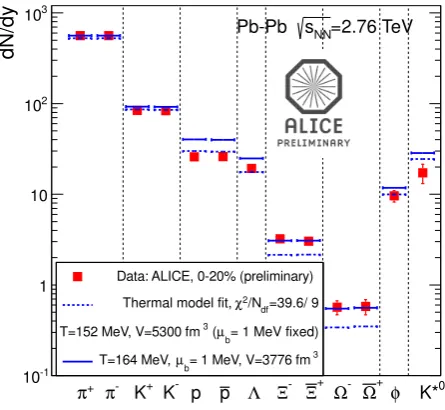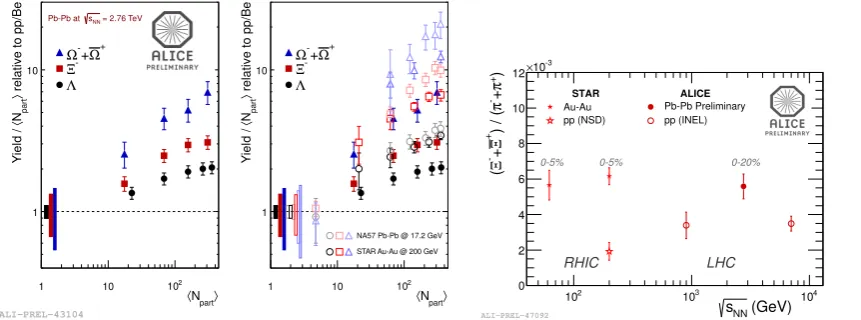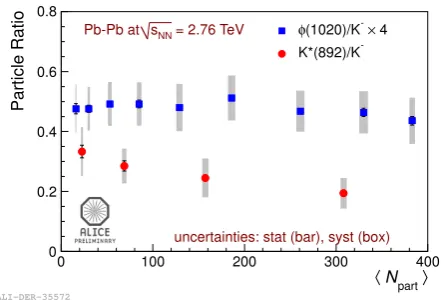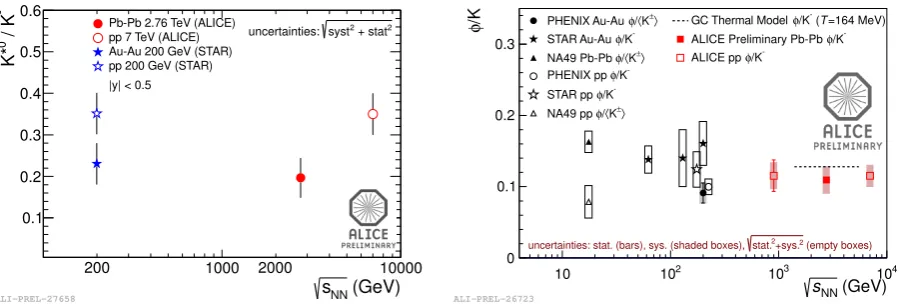Results on strange hadron and resonance production in Pb–Pb collisions at
the LHC with ALICE
Maria Nicassio1,afor the ALICE Collaboration
1Research Division and ExtreMe Matter Institute EMMI, GSI Helmholtzzentrum für Schwerionenforschung GmbH, Darmstadt,
Germany
Abstract. Strange hadrons and resonances are among the most sensitive probes to investigate the characteristics of the system formed in high-energy heavy-ion collisions. The ALICE Collaboration has measured strange hadrons and meson resonances decaying into final states with charged particles. Results on the production of K∗
(892)0andφ(1020) resonances, K0 S,Λ,Ξ
−
andΩ−
and their anti-particles at mid-rapidity in √sNN=2.76
TeV Pb–Pb collisions are presented and compared with those at lower energy and in proton–proton interactions. Our current understanding will be discussed focussing on particle ratios, thermal model fits to particle yields, strangeness enhancement and baryon anomaly.
1 Introduction
In ultra-relativistic heavy-ion collisions, when a Quark-Gluon Plasma (QGP) is formed, the production of hadrons is strongly influenced by the occurrence of the deconfined state and differs from that in elementary collisions [1]. Studying strange particle production allows the evolution of the system to be characterized and its properties to be understood. Strange quarks are (thermally) created in the QGP phase of the interaction. After the partonic medium expansion and cooling, in the hadronic phase, hadrons and resonances are produced and hadron abundances fixed at the time of the chemical freeze-out. In this phase parti-cles can still undergo elastic interactions until the kinetic freeze-out, when their momentum distributions are fixed. Strange baryons have a potentially lower hadronic scat-tering cross section than light hadrons and furthermore the multi-strange particles seem to freeze-out earlier, be-fore most of the radial flow has developed [2, 3]. On the other hand, resonances can be regenerated in the hadronic medium and in addition, having a very short mean lifetime (45 fm/cand 4 fm/cforφand K∗0, respectively), they can decay with their daughters being scattered, which may pre-vent their reconstruction. The two processes of regenera-tion and rescattering increase and decrease the signal and can lead to a modification of the measured yield compared to base line expectations in heavy-ion collisions. From particle yields and their ratios, the temperature at chemi-cal freeze-out can be determined using thermal models [4]. From resonance yields the lifetime of the hadronic phase can be inferred [5].
ae-mail: m.nicassio@gsi.de
2 Data sample and analysis
The results shown in the following are obtained with the Pb–Pb data at a centre-of-mass energy of √sNN = 2.76 TeV collected in 2010. Strange hadrons and resonances that decay into final states with charged particles only are reconstructed in ALICE. In this contribution the following main decays are covered: K0
S → π
−+π+,Λ → π−+p,
φ(1020)→ K−+K+andΞ− → π−+ Λ,Ω− → K−+ Λ
and K∗(892)0 → π+ +K− with their antiparticles. The
detectors relevant to reconstruct these decays are the Inner Tracking System, made of six silicon layers with three dif-ferent technologies, and the Time Projection Chamber [6], which also provides particle identification via the specific energy loss. For strange hadron decays, the topology is exploited (V-shaped decay topology for K0
SandΛand cas-cade decay topology for the charged Ξ andΩ baryons) applying selection criteria on geometrical and kinematical variables when combining tracks [7, 8]. Resonances are reconstructed with all possible combinations of primary tracks from opposite-charged particles. In both cases par-ticle identification of daughter tracks is used to reject false candidates. The remaining background is removed via an invariant mass analysis: in the hadron invariant mass distributions, it is fitted and subtracted, whereas for res-onances event mixing and like-sign techniques are used to estimate it [9]. Correlated residual background however survives for resonances and is subtracted performing poly-nomial fits. The analysis is performed in momentum and centrality intervals. Transverse momentum spectra are ob-tained after correcting for branching ratios, detector accep-tance and efficiency effects. Integrated yields are obtained integrating the measured spectra and using fit functions to extrapolate down to zero transverse momentum.
© Owned by the authors, published by EDP Sciences, 2013
3 Thermal model fit of particle yields
Abundances of hadrons made up of light quarks (u, d, s) are fitted in the statistical hadronization model [4]. This model is based on the assumption of a hadron gas in equi-librium, formed at the chemical freeze-out after a phase transition from a partonic medium at local thermal equi-librium. The model has a small set of parameters: T,µB, V
that are the temperature at chemical freeze-out, the baryo-chemical potential and the fireball volume, respectively. The main model elements are the partition function which contains the contributions of most hadrons and resonances and the baryon number, strangeness and charge conserva-tion laws. To describe high-energy central A–A collisions, it is formulated in the adequate grand canonical ensemble formalism: since many particles are produced per event, strangeness is conserved globally and distributed over the whole volume of the fireball. For lower-energy or periph-eral high-energy A–A collisions or in high-energy elemen-tary collisions where the initial conditions required for de-confinement are not necessarily established, the formula-tion of the statistical model in the canonical ensemble is needed with respect to strangeness conservation, that must be implemented locally because the number of produced particles is low. The exact conservation of quantum num-bers, that is the canonical approach, reduces strongly the phase-space available for particle production, thus reduc-ing their yields.
The model has been successful in describing yields in elementary and central heavy-ion collisions at low en-ergies up to RHIC enen-ergies [10]. In figure 1 the yields for mesons, baryons and resonances measured in the 20% most central collisions are shown. Predictions obtained extrapolating from RHIC data are shown as a blue line (T=164 MeV): they significantly overestimate the pro-ton andΛyields. A similar result is obtained fitting the data excluding protons and antiprotons with a good agree-ment with the data. The fit of the yields including all parti-cles except resonances (dotted lines) gives a lower temper-ature (T=152 MeV) but significantly underpredicts multi-strange baryons. Resonances are not included in the fit since the regeneration and rescattering processes can pro-duce a variation which is not accounted for in the model. A similar disagreement is already present at RHIC top en-ergy [11] and can indicate an anomaly in the proton yield, caused by annihilation of pp pairs between chemical and kinetic freeze-out. This hypothesis is supported by model calculations [12, 13]. However annihilation should also af-fect strange baryons, even though slightly, as data suggest. Recently, particle yields measured by the ALICE Col-laboration in different centrality intervals have been fitted with a chemical non-equilibrium implementation of the model [14]. In this implementation the phase space oc-cupancy factorsγs,q, which are additional non-equilibrium
parameters introduced in some models to account for non-thermal production, are used. This approach relies on a sudden hadronization which occurs from a cool QGP (T ≈140 MeV) in thermal equilibrium, so that there is no significant modification of the quark abundances and they remain close to the chemical equilibrium values.
dN/dy
-1 10
1 10 2 10
3 10
Data: ALICE, 0-20% (preliminary)
=39.6/ 9
df
/N
2 χ
Thermal model fit,
= 1 MeV fixed)
b µ
(
3
T=152 MeV, V=5300 fm
3
= 1 MeV, V=3776 fm
b µ
T=164 MeV,
=2.76 TeV NN
s Pb-Pb
+
π π- K+ K p- p Λ Ξ- Ξ+ Ω- Ω φ+ K*0 ALI−DER−37755
Figure 1. Particle yields measured in the 0-20% most central Pb–Pb collisions at√sNN=2.76 TeV (red symbols) with the
pre-diction of the thermal model from RHIC extrapolation (blue line) and the fit performed excluding resonances (dotted blue line).
4 Strangeness enhancement
〉 part
N
〈
1 10 102
relative to pp/Be
〉
part
N
〈
Y
ie
ld
/
1 10
= 2.76 TeV NN s Pb-Pb at
+ Ω
+
-Ω -Ξ Λ
〉 part
N
〈
1 10 102
relative to pp/Be
〉
part
N
〈
Y
ie
ld
/
1 10
+ Ω
+
-Ω -Ξ Λ
NA57 Pb-Pb @ 17.2 GeV STAR Au-Au @ 200 GeV
ALI−PREL−43104 sNN (GeV)
2
10 103 104
)
+
π
+
-π
) / (
+
Ξ
+
-Ξ
(
0 2 4 6 8 10 12
-3
10
×
RHIC LHC
0-5% 0-5% 0-20%
STAR ALICE
Au-Au Pb-Pb Preliminary pp (NSD) pp (INEL)
ALI−PREL−47092
Figure 2.Left panels: strangeness enhancement of baryons as a function of the mean number of participants measured by ALICE in Pb–Pb collisions (full symbols) with respect to pp collisions compared to that measured at lower energies (hollow symbols) by NA57 and STAR in Pb–Pb (normalized to p–Be) and Au–Au (normalized to pp) collisions respectively. The boxes on the dotted lines represent the systematic uncertainties on the pp and p–Be reference (hNparti=2 and 2.5 respectively). The hollow symbols athNparti=4.75 are
WA97 measurements in p–Pb collisions normalized to p–Be collisions. For ALICE data the reference is calculated interpolating data as described in [8]. Right panel: hyperon-to-pion ratio as a function of the centre-of-mass energy for heavy-ion (full symbols) and pp (hollow symbols) collisions for ALICE and STAR data.
of canonical suppression in elementary collisions as the centre-of-mass energy increases and explains the trend of the enhancements with energy. As for the centrality de-pendence, the experimental results are both due to the lift-ing of strangeness suppression in central heavy-ion colli-sions, in agreement with the grand canonical description of the thermal model, and a result of the charged multi-plicity increase with centrality [17]. More detailed exper-imental studies and theoretical understanding are needed to explain all the features of the lifting of strangeness sup-pression observed so far in a consistent picture, such as the centrality dependence, which is not well reproduced with the thermal model, the magnitude, which is not correctly predicted, and the dependence on the size of the colliding system.
5 Baryon anomaly
It was first observed at RHIC that the production of baryons becomes similar to that of mesons in central heavy-ion collisions at intermediate transverse momentum (3<pT<5 GeV/c) when comparing proton and pion yields and, in the strange sector,Λ and K0
S yields. In figure 3 (left panel) the ratio of strange baryon to meson yields,
Λ/K0
Sratio, as a function of pT is shown for several cen-trality classes and compared to the same ratio in pp col-lisions: the production ratio is similar in peripheral A–A and pp collisions and increases from the most peripheral classes to the most central. The peak shifts towards higher
pT and becomes higher going from the most peripheral to the most central collisions (right panel of figure 3). A possible explanation is the recombination of quarks as an additional hadronization mechanism in presence of a de-confined medium at intermediate pT. The recombination mechanism is implemented in models based on quark coa-lescence [20], which should not be at work in pp collisions
due to the low phase space density in the final state. Such models were successful in describing RHIC data. A redis-tribution of the produced baryons at higher momentum due to radial flow is also conceivable and is consistent with the shift of the maximum towards higher pT as centrality in-creases. However, the interplay of effects which are domi-nant in the low, mid and high momentum regions has to be considered in models of hadronization in heavy-ion colli-sions. A good description of the behaviour in centrality classes and over the whole pTrange is obtained with the EPOS hadronic interaction model [19], as it can be seen in figure 3 (left panel). In this model particle production from a hadron–hadron interaction has three main sources: a soft and a hard part and the contribution of the remnants of the two hadrons. It also includes nuclear effect and hy-drodynamics.
6 Resonance to non-resonance ratios
The two competing processes of regeneration and rescat-tering could affect the measured yields of resonances. Their relative strength can be inferred from resonant to non-resonant particle yield ratios and comparing them to thermal model predictions. The ratio of resonances to negatively-charged kaons is shown in figure 4 for A–A and pp interactions: no significant variation is seen for theφ, while for the K∗0the ratio is lower in A–A than in pp col-lision, as already observed at RHIC. As shown in figure 5, the ratio does not depend on centrality for theφ, whereas shows a decrease with centrality for the K∗0.
(GeV/c)
T
p
0 1 2 3 4 5 6 7 8
S
0
/ K
Λ
0 0.5 1 1.5 2 2.5
0-5 % centrality 20-40 % centrality 40-60 % centrality 60-80 % centrality 80-90 % centrality = 7 TeV) s (pp at
= 0.9 TeV) s (pp at
data points include stat. errors estimated syst. error ~10 %
Preliminary
= 2.76 TeV, |y|<0.75 NN
s Pb-Pb at
EPOS 0-5 % 2.17v3 20-40 %
40-60 % 60-80 %
arXiv 1204.1394
ALI−PREL−23080 〈NPART〉
1 10 102 3
10
maximum (GeV/c)S
0
/ K
0
Λ
at T
p
0 1 2 3 4 5
maximum value S
0
/ K
0
Λ
0 0.5 1 1.5 2 2.5 3 3.5 4 4.5 5
= 2.76 TeV
NN
s Pb-Pb events at
maximum S 0 /K 0
Λ at T p
maximum value 0
S /K 0
Λ
Preliminary
Figure 3.Left panel: baryon-to-meson yield ratio forΛand K0
Sas a function ofpTfor several centrality intervals in Pb–Pb collisions
and for pp collisions at two energies. Pb–Pb data are compared to the prediction of the EPOS model. Right panel: properties of the
maximum of theΛ/K0
Sratio. The height (red symbols) and the position inpT(blue symbols) are shown as a function of centrality.
there is a fair agreement for the φ/K ratio with the ther-mal model prediction and not for the K∗0/K ratio, which is clearly overpredicted. The absence of centrality depen-dence of the φ/K ratio also disfavours φ production via kaon coalescence, predicted in hadron transport models, such as RQMD and UrQMD [21], as the dominant pro-duction mechanism for mesons. In these models the ratio is larger for more central collisions.
7 Summary and conclusions
Some of the main results on strangeness production in Pb–Pb collisions obtained by the ALICE Collaboration have been presented and compared to the observations at lower energies and in pp collisions. These results are valu-able in the interpretation of the effects and characteris-tics related to particle production, not only specifically in the strangeness sector, though further investigation is still needed both on the theoretical and the experimental side. Tensions are observed when fitting particle yields in the equilibrium statistical hadronization model. This opens the question whether a common freeze-out picture is still valid at the LHC and this feature is (in fact) already present at lower energy. It can also point to an issue with proton yields that can be better investigated with further precision measurements, including correlations among baryons and anti-baryons to study annihilation. It can even be a hint of non-equilibrium of the hadron gas. Therefore more inves-tigation is required for hadrons which exhibit challenges to the model, such as protons and multi-strange baryons. The pattern of the strangeness enhancement, established at lower energies, is confirmed at the LHC. The observed effect can be better quantified with strange to non-strange yield ratios to disentangle the contributions convoluted in the usual definition of enhancements, i.e. canonical sup-pression in elementary collisions, the lifting of suppres-sion in heavy-ion collisuppres-sions and the growth of charged multiplicity with centrality. More studies can also help to understand the features observed at lower energy in diff er-ent colliding systems. The so-called baryon anomaly has
〉
part
N 〈
0 100 200 300 400
Particle Ratio
0 0.2 0.4 0.6 0.8
= 2.76 TeV
NN
s Pb-Pb at
uncertainties: stat (bar), syst (box)
4
×
-(1020)/K
φ
-K*(892)/K
ALI−DER−35572
Figure 5.Resonance to non-resonance yield ratios as a function of centrality forφand K∗0
.
to be further investigated as well, and our data are impor-tant to test models of particle hadronization and transport in order to identify the origin of the increased production of baryons compared to mesons at intermediate pT. Pos-sible explanations are a redistribution due to flow and the interplay of quark recombination and fragmentation. Fur-ther studies are also ongoing for resonances to understand the role played by rescattering and regeneration in the ob-served abundances.
References
[1] J. Knoll, Nucl. Phys. A821, 235 (2009)
[2] H. van Hecke, H. Sorge and N. Xu, Nucl. Phys. A661, 493c (1999)
[3] J. Adamset al.(STAR Collaboration), Nucl. Phys. A
757, 102 (2005)
(GeV) NN s
200 1000 2000 10000
/ K
0
K*
0.1 0.2 0.3 0.4 0.5 0.6
Pb-Pb 2.76 TeV (ALICE) pp 7 TeV (ALICE) Au-Au 200 GeV (STAR) pp 200 GeV (STAR)
2 + stat 2 syst uncertainties:
|y| < 0.5
ALI−PREL−27658 NN (GeV)
s
10 102 103 104
/K
φ
0 0.1 0.2 0.3
(empty boxes) 2
+sys. 2 stat. uncertainties: stat. (bars), sys. (shaded boxes),
〉
±
K
〈
/
φ
PHENIX Au-Au -/K
φ
STAR Au-Au
〉
±
K
〈
/
φ
NA49 Pb-Pb -/K
φ
PHENIX pp -/K
φ
STAR pp
〉
±
K
〈
/
φ
NA49 pp
=164 MeV)
T
( -/K
φ
GC Thermal Model -/K
φ
ALICE Preliminary Pb-Pb -/K
φ
ALICE pp
ALI−PREL−26723
Figure 4. Resonance to non-resonance yield ratios for K∗0(left panel) andφ(right panel) as a function of the centre-of-mass energy
for pp and A–A collisions. The thermal model prediction for LHC energies (T=164 MeV) is also shown for theφ/K ratio.
[5] G. Torrieri and J. Rafelski, J.Phys. G28, 191 (2002) C. Markert, G. Torrieri and J. Rafelski, Proceedings of PASI 2002, arXiv:hep-ph/0206260 (2002)
[6] K. Aamodt et al. (ALICE Collaboration), JINST3, S08002 (2008)
[7] B. Abelev et al. (ALICE Collaboration),
arXiv:1307.5530 [nucl-ex] (2013)
[8] B. Abelev et al. (ALICE Collaboration),
arXiv:1307.5543 [nucl-ex] (2013)
[9] A. G. Knospe for the ALICE Collaboration, J. Phys.: Conf. Ser.420, 012018 (2013)
[10] A. Andronic, P. Braun-Munzinger, J. Stachel, Phys. Lett. B 673,142 (2009); Erratum: ibid. B 678, 516 (2009); Acta Phys. Pol.40, 1005 (2009)
[11] A. Andronic, P. Braun-Munzinger, K. Redlich, J. Stachel, Nucl. Phys. A904-905, 535c (2013)
[12] J. Steinheimer, J. Aichelin and M. Bleicher, Phys. Rev. Lett. 110, 042501 (2013)
[13] Y. Pan and S. Pratt, arXiv:1210.1577 [nucl-th] [14] M. Petran, J. Rafelski, arXiv:1303.0913 [hep-ph]
M. Petran, J. Letessieret al., arXiv:1303.2098 [hep-ph] [15] J. Rafelski, B. Müller, Phys. Rev. Lett. 48, 1066
(1982)
P. Koch, J. Rafelski, W. Greiner, Phys. Lett. B123, 151 (1983)
P. Koch, B. Müller, J. Rafelski, Phys. Rep.142, 167 (1986)
[16] E. Andersenet al.(WA97 Collaboration), Phys. Lett. B449, 401 (1999); ibid. 443, 209 (1998)
F. Antinoriet al.(NA57 Collaboration), J. Phys. G32, 427 (2006)
F. Antinoriet al.(NA57 Collaboration), J. Phys. G37, 045105 (2010)
B. I. Abelevet al.(STAR Collaboration), Phys. Rev. C
77, 044908 (2008)
G. Agakishievet al.(STAR Collaboration), Phys. Rev. Lett.108, 72301 (2012)
[17] K. Aamodtet al.(ALICE Collaboration), Phys. Rev. Lett.106, 032301 (2011)
[18] J. Schaffner-Bielich, J. Phys. G30, R245 (2004) [19] K. Werneret al., Phys. Rev. C85, 064907 (2012) [20] R. Fries, V. Greco and P. Sorensen, Annu. Rev. Nucl.
Part. Sci.58, 177 (2008)
[21] M. Bleicheret al., J. Phys. G25, 1859 (1999) H. Sorge, Phys. Rev. C52, 3291 (1995)



